Spreadability of Metal Powders for Laser-Powder Bed Fusion via Simple Image Processing Steps
Abstract
:1. Introduction
2. Materials and Methods
2.1. Powders Bed Analysis
2.2. 3D Printing of the Powder Bed
3. Results and Discussion
3.1. CoCrWMo Powders Characteristics
3.2. Powders Spreadability by Image Processing
3.3. Production of 3D Printed Cubes
4. Conclusions
Author Contributions
Funding
Institutional Review Board Statement
Informed Consent Statement
Data Availability Statement
Acknowledgments
Conflicts of Interest
References
- Neirinck, B.; Li, X.; Hick, M. Powder deposition systems used in powder bed-based multimetal additive manufacturing. Acc. Mater. Res. 2021, 2, 387–393. [Google Scholar] [CrossRef]
- Anstaett, C.; Seidel, C. Multi-Material Processing: Next step in laser-based powder bed fusion. Laser Tech. J. 2016, 13, 28–31. [Google Scholar] [CrossRef]
- INTERNATIONAL STANDARD ISO/ASTM 52900: 2015 Additive Manufacturing—General Principles—Terminology. Available online: https://www.iso.org/standard/69669.html#:~:text=ISO%2FASTM%2052900%3A2015%20establishes,into%20specific%20fields%20of%20application (accessed on 21 December 2021).
- Kuo, C.N.; Chua, C.K.; Peng, P.C.; Chen, Y.W.; Sing, S.L.; Huang, S.; Su, Y.L. Microstructure evolution and mechanical property response via 3D printing parameter development of Al–Sc alloy. Virtual Phys. Prototyp. 2020, 15, 120–129. [Google Scholar] [CrossRef]
- Bi, J.; Lei, Z.; Chen, Y.; Chen, X.; Tian, Z.; Liang, J.; Qin, X.; Zhang, X. Densification, microstructure and mechanical properties of an Al-14.1Mg-0.47Si-0.31Sc-0.17Zr alloy printed by selective laser melting. Mater. Sci. Eng. A 2020, 774, 138931. [Google Scholar] [CrossRef]
- Wen, S.; Wang, C.; Zhou, Y.; Duan, L.; Wei, Q.; Yang, S.; Shi, Y. High-density tungsten fabricated by selective laser melting: Densification, microstructure, mechanical and thermal performance. Opt. Laser Technol. 2019, 116, 128–138. [Google Scholar] [CrossRef]
- Du, Z.; Chen, H.-C.; Tan, M.J.; Bi, G.; Chua, C.K. Effect of nAl2O3 on the part density and microstructure during the laser-based powder bed fusion of AlSi10Mg composite. Rapid Prototyp. J. 2020, 26, 727–735. [Google Scholar] [CrossRef]
- Martinez, R.; Todd, I.; Mumtaz, K. In situ alloying of elemental Al-Cu12 feedstock using selective laser melting. Virtual Phys. Prototyp. 2019, 14, 242–252. [Google Scholar] [CrossRef]
- Huang, S.; Sing, S.L.; de Looze, G.; Wilson, R.; Yeong, W.Y. Laser powder bed fusion of titanium-tantalum alloys: Compositions and designs for biomedical applications. J. Mech. Behav. Biomed. Mater. 2020, 108, 103775. [Google Scholar] [CrossRef]
- Petrousek, P.; Kvackaj, T.; Kocisko, R.; Bidulska, J.; Luptak, M.; Manfredi, D.; Grande, M.A.; Bidulsky, R. Influence of cryorolling on properties of L-PBF 316L stainless steel tested at 298K and 77K. Acta Metall. Slovaca 2019, 25, 283–290. [Google Scholar] [CrossRef]
- Zhang, W.; Mehta, A.; Desai, P.S.; Higgs, C. Machine learning enabled powder spreading process map for metal additive manufacturing (AM). In Proceedings of the 28th Annual International Solid Freeform Fabrication Symposium, Austin, TX, USA, 7–9 August 2017; pp. 1235–1249. [Google Scholar]
- Cordova, L.; Bor, T.; de Smit, M.; Campos, M.; Tinga, T. Measuring the spreadability of pre-treated and moisturized powders for laser powder bed fusion. Addit. Manuf. 2020, 32, 101082. [Google Scholar] [CrossRef]
- Vock, S.; Klöden, B.; Kirchner, A.; Weißgärber, T.; Kieback, B. Powders for powder bed fusion: A review. Prog. Addit. Manuf. 2019, 4, 383–397. [Google Scholar] [CrossRef]
- International Organization for Standardization. INTERNATIONAL STANDARD ISO/ASTM 52907: 2019 Additive Manufacturing—Feedstock Materials—Methods to Characterize Metallic Powders. Available online: https://www.iso.org/standard/73565.html (accessed on 21 December 2021).
- Mussatto, A.; Groarke, R.; O’Neill, A.; Obeidi, M.A.; Delaure, Y.; Brabazon, D. Influences of powder morphology and spreading parameters on the powder bed topography uniformity in powder bed fusion metal additive manufacturing. Addit. Manuf. 2021, 38, 101807. [Google Scholar] [CrossRef]
- Gu, H.; Gong, H.; Dilip, J.; Pal, D.; Hicks, A.; Doak, H.; Stucker, B. Effects of powder variation on the microstructure and tensile strength of Ti6Al4V parts fabricated by selective laser melting. In Proceedings of the 25th Annual International Solid Freeform Fabrication Symposium, Austin, TX, USA, 4–6 August 2014; pp. 4–6. [Google Scholar]
- Balbaa, M.; Ghasemi, A.; Fereiduni, E.; Elbestawi, M.; Jadhav, S.; Kruth, J.-P. Role of powder particle size on laser powder bed fusion processability of AlSi10mg alloy. Addit. Manuf. 2021, 37, 101630. [Google Scholar] [CrossRef]
- Heiden, M.J.; Deibler, L.A.; Rodelas, J.M.; Koepke, J.R.; Tung, D.J.; Saiz, D.J.; Jared, B.H. Evolution of 316L stainless steel feedstock due to laser powder bed fusion process. Addit. Manuf. 2019, 25, 84–103. [Google Scholar] [CrossRef]
- Geldart, D.; Abdullah, E.C.; Hassanpour, A.; Nwoke, L.C.; Wouters, I. Characterization of powder flowability using measurement of angle of repose. China Particuol. 2006, 4, 104–107. [Google Scholar] [CrossRef]
- Snow, Z.; Martukanitz, R.; Joshi, S. On the development of powder spreadability metrics and feedstock requirements for powder bed fusion additive manufacturing. Addit. Manuf. 2019, 28, 78–86. [Google Scholar] [CrossRef]
- Sutton, A.T.; Kriewall, C.S.; Karnati, S.; Leu, M.C.; Newkirk, J.W. Characterization of AISI 304L stainless steel powder recycled in the laser powder-bed fusion process. Addit. Manuf. 2020, 32, 100981. [Google Scholar] [CrossRef]
- Powell, D.; Rennie AE, W.; Geekie, L.; Burns, N. Understanding powder degradation in metal additive manufacturing to allow the upcycling of recycled powders. J. Clean. Prod. 2020, 268, 122077. [Google Scholar] [CrossRef]
- Brandon, L.; Eric, W.; Shawn, M. Multiple sensor detection of process phenomena in laser powder bed fusion. In Thermosense: Thermal Infrared Applications XXXVIII; The International Society for Optical Engineering: Baltimore, MD, USA, 2016; Volume 9861, p. 986104. [Google Scholar] [CrossRef]
- Prescott, J.K.; Barnum, R.A. On powder flowability. Pharm. Technol. 2000, 24, 60–85. [Google Scholar]
- Brika, S.E.; Letenneur, M.; Dion, C.A.; Brailovski, V. Influence of particle morphology and size distribution on the powder flowability and laser powder bed fusion manufacturability of Ti-6Al-4V alloy. Addit. Manuf. 2020, 31, 100929. [Google Scholar] [CrossRef]
- Escano, L.I.; Parab, N.D.; Xiong, L.; Guo, Q.; Zhao, C.; Fezzaa, K.; Everhart, W.; Sun, T.; Chen, L. Revealing particle-scale powder spreading dynamics in powder-bed-based additive manufacturing process by high-speed X-ray imaging. Sci. Rep. 2018, 8, 1–11. [Google Scholar] [CrossRef]
- Hulme-Smith, C.N.; Hari, V.; Mellin, P. Spreadability testing of powder for additive manufacturing. BHM Berg Huttenmann. Monatshefte 2021, 166, 9–13. [Google Scholar] [CrossRef]
- Chen, H.; Wei, Q.; Zhang, Y.; Chen, F.; Shi, Y.; Yan, W. Powder-spreading mechanisms in powder-bed-based additive manufacturing: Experiments and computational modeling. Acta Mater. 2019, 179, 158–171. [Google Scholar] [CrossRef]
- Nan, W.; Pasha, M.; Bonakdar, T.; Lopez, A.; Zafar, U.; Nadimi, S.; Ghadiri, M. Jamming during particle spreading in additive manufacturing. Powder Technol. 2018, 338, 253–262. [Google Scholar] [CrossRef]
- Meier, C.; Weissbach, R.; Weinberg, J.; Wall, W.A.; John Hart, A. Modeling and characterization of cohesion in fine metal powders with a focus on additive manufacturing process simulations. Powder Technol. 2019, 343, 855–866. [Google Scholar] [CrossRef]
- Ahmed, M.; Pasha, M.; Nan, W.; Ghadiri, M. A simple method for assessing powder spreadability for additive manufacturing. Powder Technol. 2020, 367, 671–679. [Google Scholar] [CrossRef]
- ASTM-American Society for Testing and Materials. ASTM D3576-15 Standard Test Method for Cell Size of Rigid Cellular Plastics; ASTM International: West Conshohocken, PA, USA, 2015. [Google Scholar]
- Semerci, T.; de Mello Innocentini, M.D.; Marsola, G.A.; Lasso PR, O.; Soraru, G.D.; Vakifahmetoglu, C. Hot air permeable preceramic polymer derived reticulated ceramic foams. ACS Appl. Polym. Mater. 2020, 2, 4118–4126. [Google Scholar] [CrossRef]
- Bootz, A.; Vogel, V.; Schubert, D.; Kreuter, J. Comparison of scanning electron microscopy, dynamic light scattering and analytical ultracentrifugation for the sizing of poly (butyl cyanoacrylate) nanoparticles. Eur. J. Pharm. Biopharm. 2004, 57, 369–375. [Google Scholar] [CrossRef]
- Spierings, A.B.; Herres, N.; Levy, G. Influence of the particle size distribution on surface quality and mechanical properties in AM steel parts. Rapid Prototyp. J. 2011, 17, 195–202. [Google Scholar] [CrossRef]
- Sola, A.; Nouri, A. Microstructural porosity in additive manufacturing: The formation and detection of pores in metal parts fabricated by powder bed fusion. J. Adv. Manuf. Process. 2019, 1, e10021. [Google Scholar] [CrossRef]
- Strondl, A.; Lyckfeldt, O.; Brodin, H.; Ackelid, U. Characterization and control of powder properties for additive manufacturing. J. Miner. Met. Mater. Soc. 2015, 67, 549–554. [Google Scholar] [CrossRef]
- Kim, F.H.; Moylan, S.P.; Garboczi, E.J.; Slotwinski, J.A. Investigation of pore structure in cobalt chrome additively manufactured parts using X-ray computed tomography and three-dimensional image analysis. Addit. Manuf. 2017, 17, 23–38. [Google Scholar] [CrossRef]
- Bidulská, J.; Bidulský, R.; Actis Grande, M.; Kvačkaj, T. Different formation routes of pore structure in aluminum powder metallurgy alloy. Materials 2019, 12, 3724. [Google Scholar] [CrossRef] [PubMed]
- Puscas, T.M.; Signorini, M.; Molinari, A.; Straffelini, G. Image analysis investigation of the effect of the process variables on the porosity of sintered chromium steels. Mater. Charact. 2003, 50, 1–10. [Google Scholar] [CrossRef]

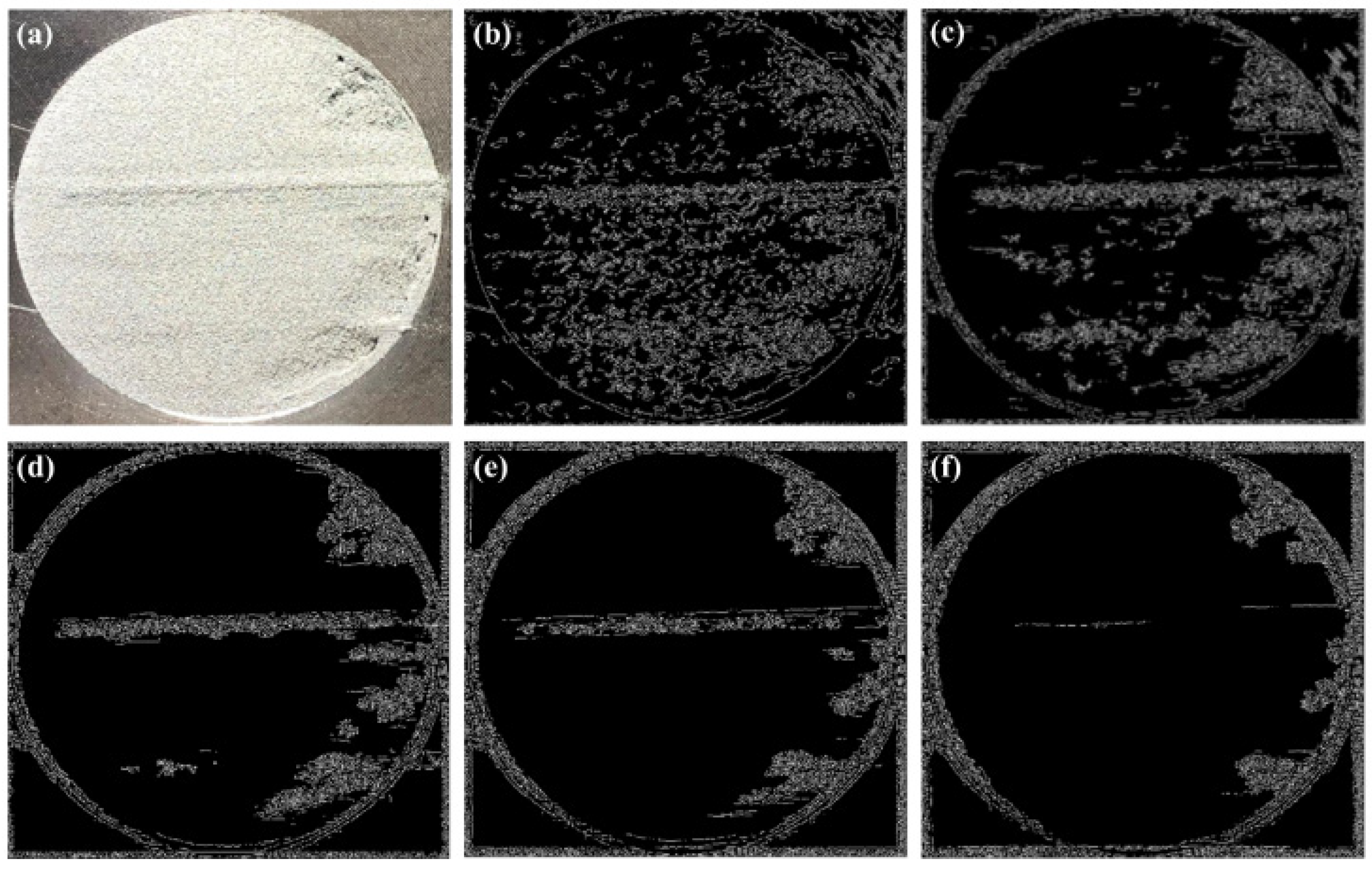
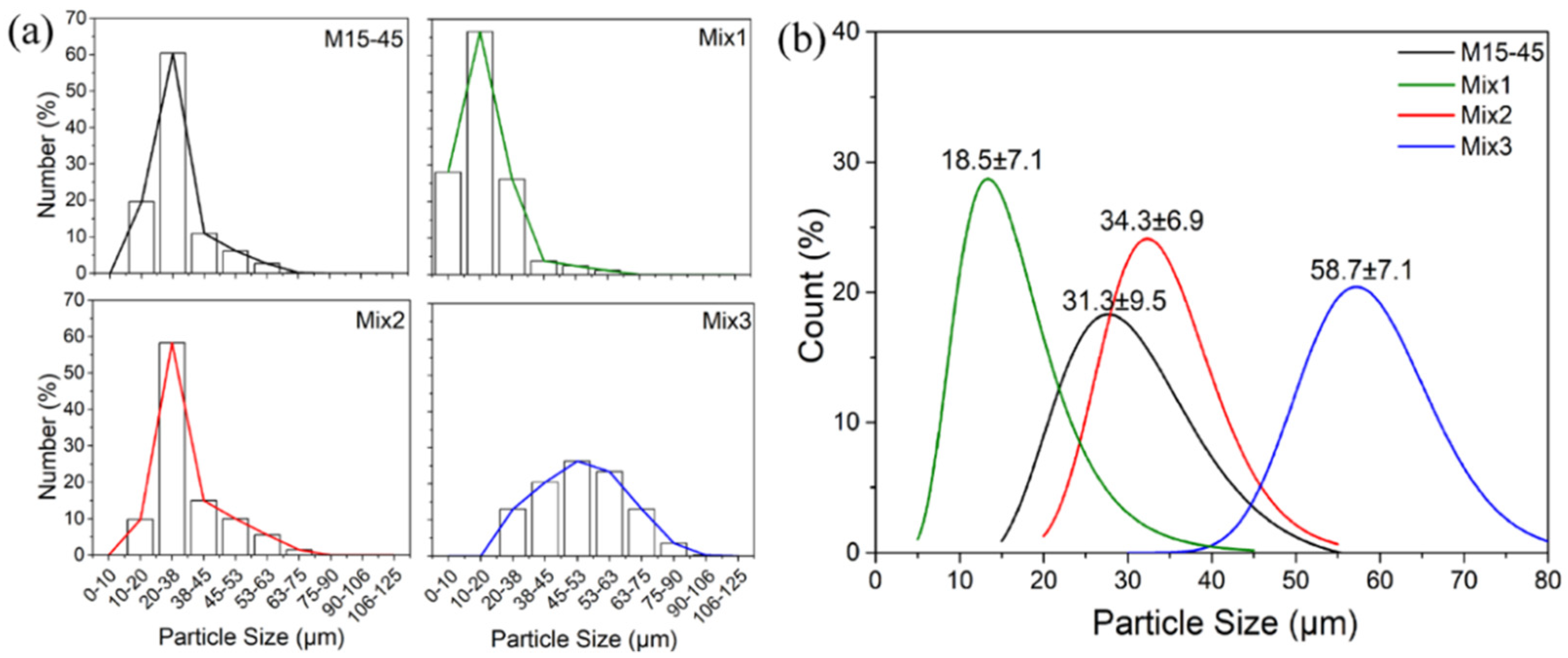
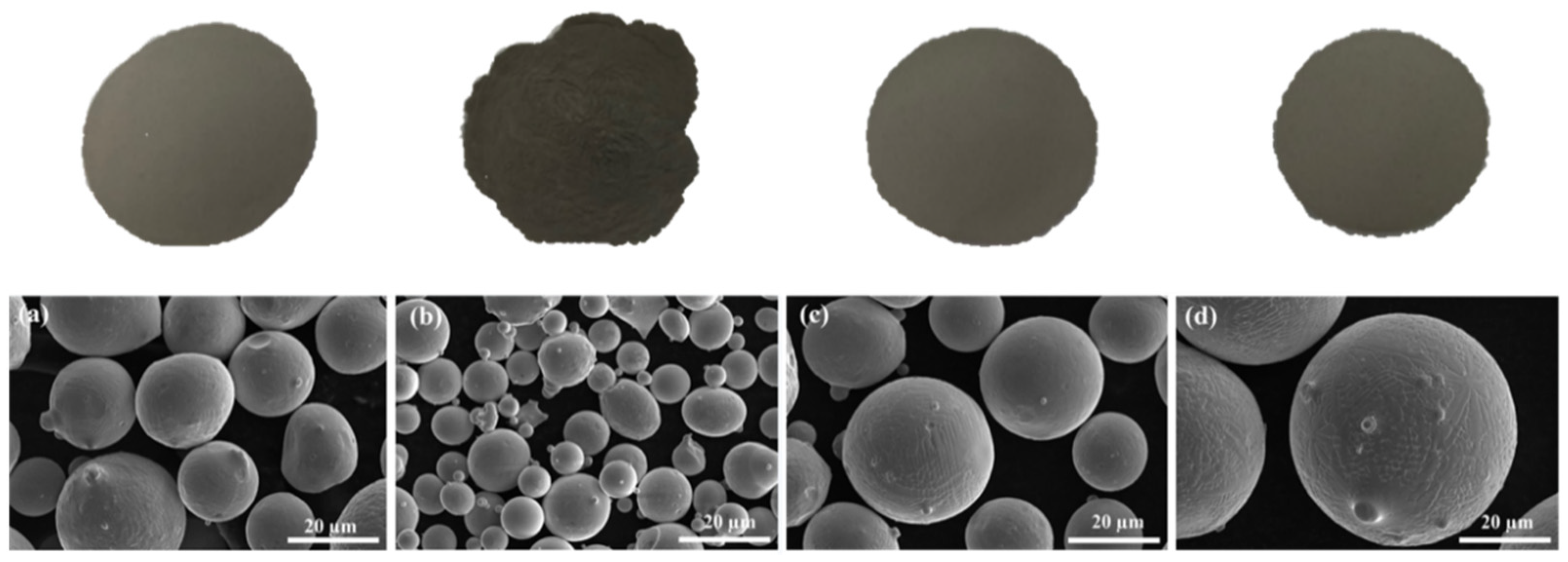
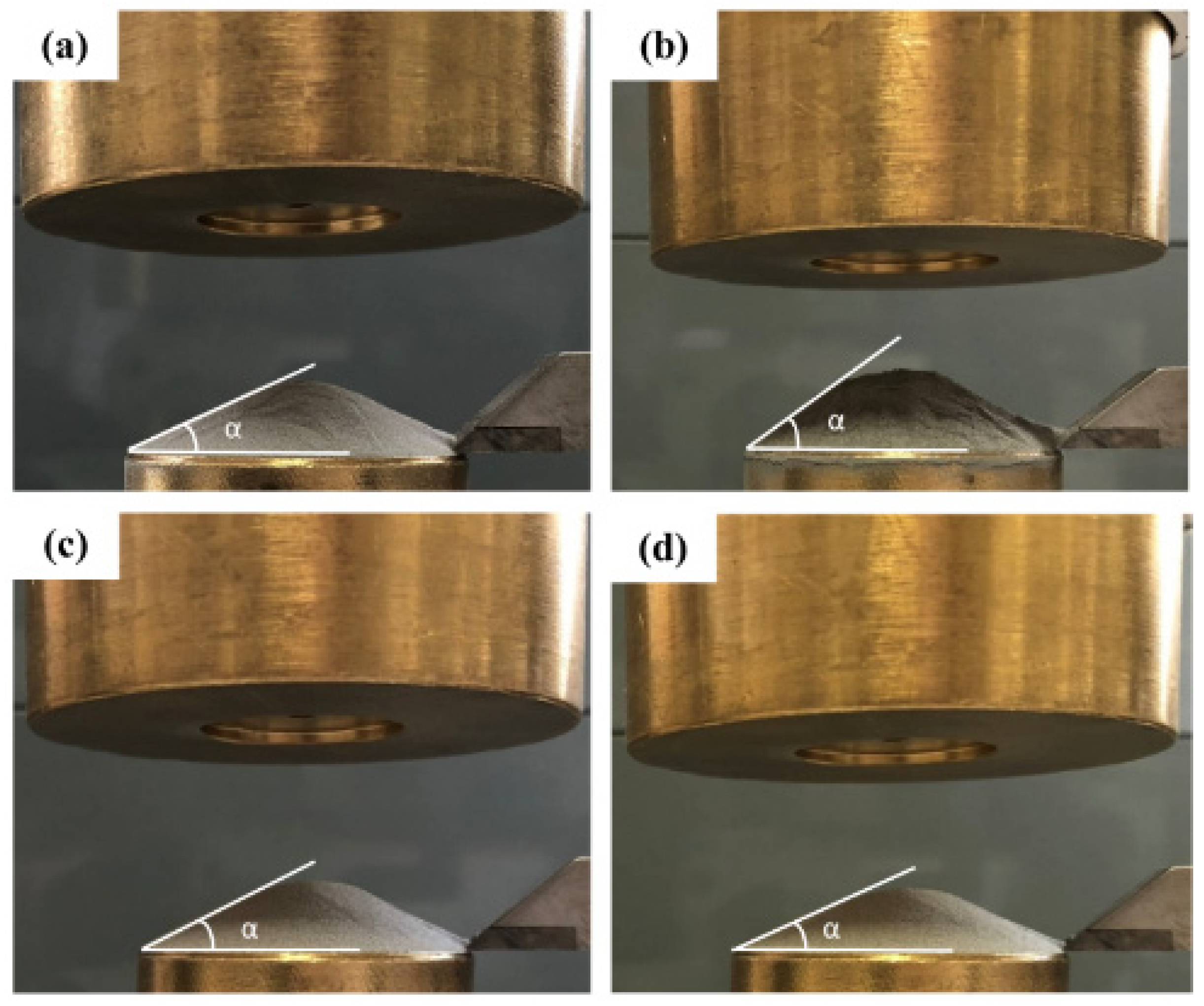
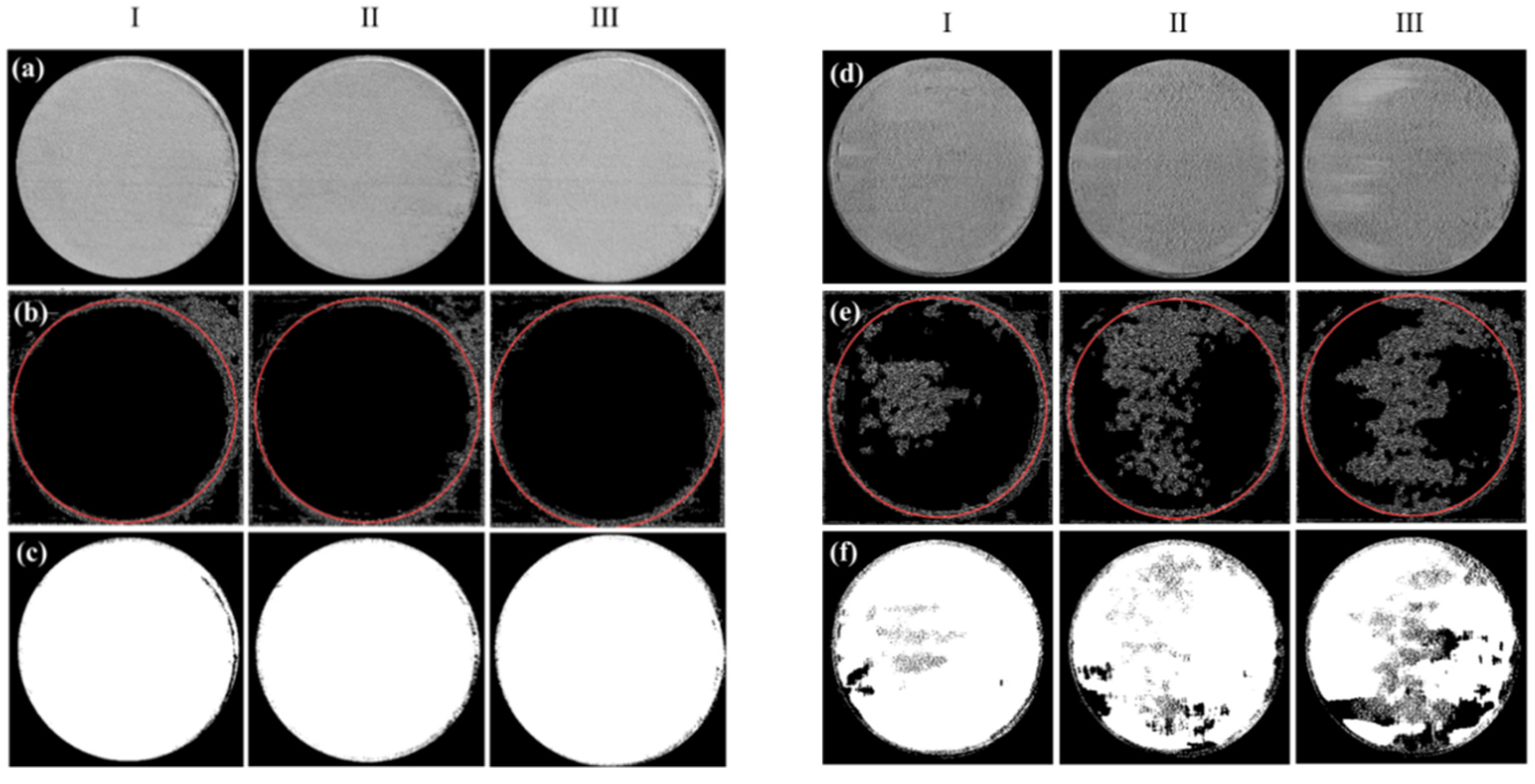
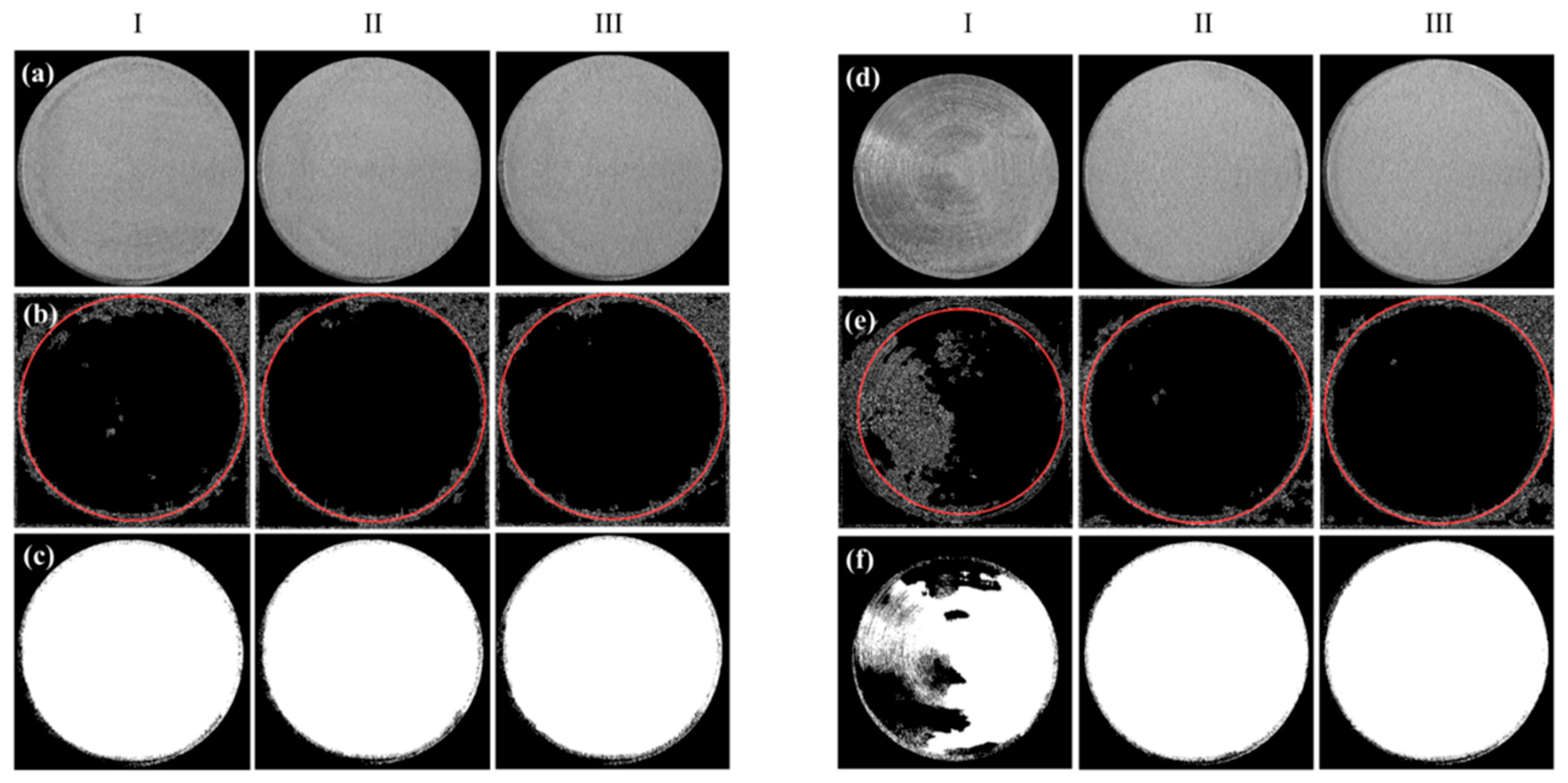

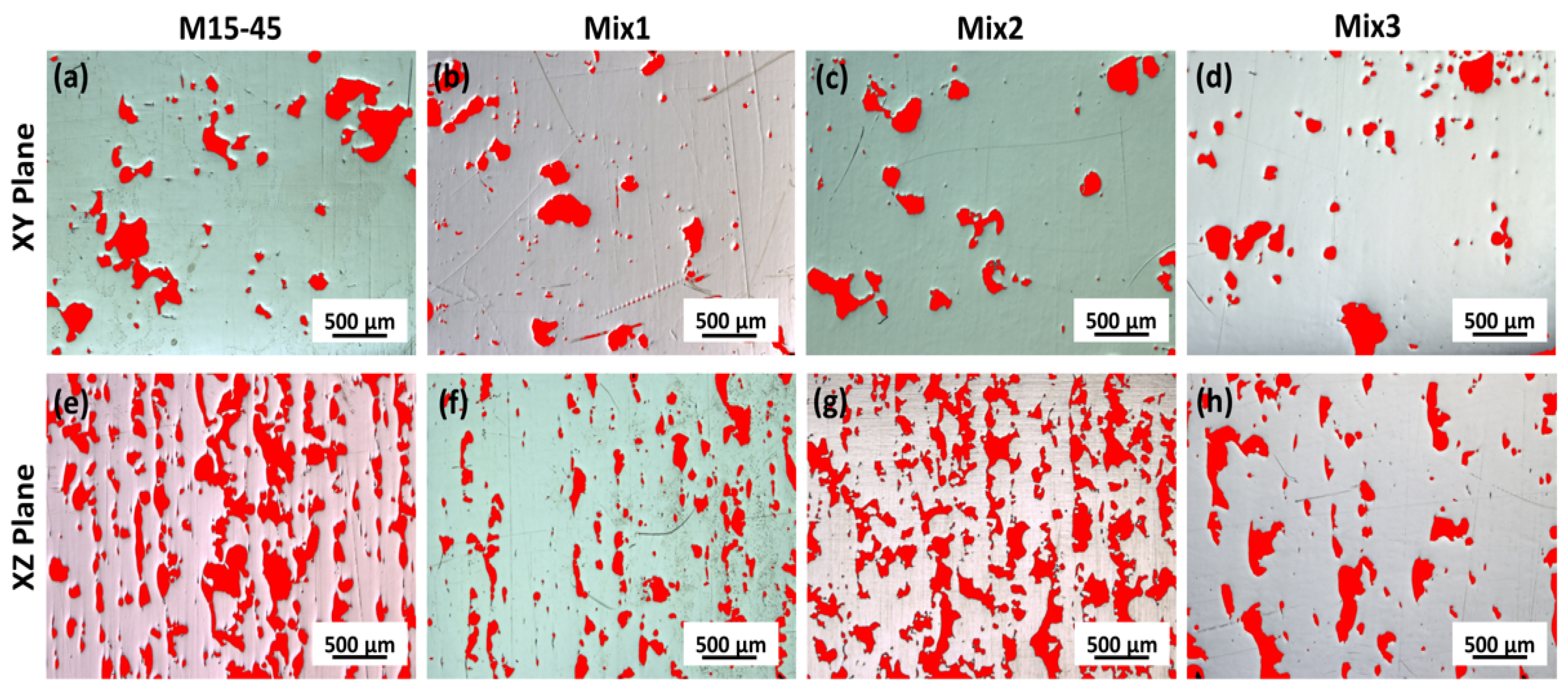
| Laser spot size (μm) | 50 |
| Layer thickness (μm) | 50 |
| Hatch distance (μm) | 50 |
| Laser power (W) | 200 |
| Laser wavelength (nm) | 1064 |
| Sample Code | M15-45 | Mix1 | Mix2 | Mix3 |
|---|---|---|---|---|
| D10 (µm) | 17.13 | 0.25 | 20.07 | 36.58 |
| D50 (µm) | 27.71 | 14.94 | 32.02 | 49.92 |
| D90 (µm) | 44.18 | 34.56 | 50.00 | 67.90 |
| ≤10 (µm) | 0 | 28.06 | 0 | 0 |
| ≤20 µm (%) | 19.66 | 66.58 | 9.82 | 0 |
| 20 µm–38 µm (%) | 60.37 | 26.13 | 58.21 | 13 |
| 38 µm–45µm (%) | 10.91 | 3.78 | 14.98 | 20.42 |
| 45 µm–53 µm (%) | 6.17 | 2.40 | 9.97 | 26.34 |
| 53 µm–63 µm (%) | 2.65 | 1.11 | 5.55 | 23.41 |
| 63 µm–75 µm (%) | 0.24 | 0 | 1.47 | 13.02 |
| 75 µm–90 µm (%) | 0 | 0 | 0 | 3.56 |
| 90 µm–106 µm (%) | 0 | 0 | 0 | 0.25 |
| 106 µm–125 µm (%) | 0 | 0 | 0 | 0 |
| Sample Code | M15-45 | Mix1 | Mix2 | Mix3 |
|---|---|---|---|---|
| Apparent density (g cm−3) | 4.78 | 4.97 | 4.80 | 4.86 |
| Tap density (g cm−3) | 5.29 | 5.55 | 4.96 | 5.23 |
| Flow rate (s/50 g) | 15.08 | - | 14.35 | 14.19 |
| Angle of Repose (AOR, °) | 22.39 | 32.85 | 22.01 | 21.33 |
| Oxygen amount (ppm) | 246 | 384 | 241 | 207 |
| Sample | Average Grayscale Value (0 to 255) | Black to White Ratio |
|---|---|---|
| M15-45-Layer 1 | 119.84 | 0.31 |
| M15-45-Layer 2 | 115.96 | 0.30 |
| M15-45-Layer 3 | 135.05 | 0.26 |
| Mix1-Layer 1 | 94.49 | 0.37 |
| Mix1-Layer 2 | 91.98 | 0.40 |
| Mix1-Layer 3 | 92.66 | 0.46 |
| Mix2-Layer 1 | 107.04 | 0.31 |
| Mix2-Layer 2 | 107.38 | 0.32 |
| Mix2-Layer 3 | 107.33 | 0.31 |
| Mix3-Layer 1 | 82.38 | 0.60 |
| Mix3-Layer 2 | 113.67 | 0.30 |
| Mix3-Layer 3 | 115.09 | 0.30 |
| Sample | Bulk Density (g·cm−3) (Geometric) | Total Porosity (vol%) (Geometric) | Bulk Density (g·cm−3) (Archimedes) | Total Porosity (vol%) (Archimedes) | Open Porosity (vol%) (Archimedes) |
|---|---|---|---|---|---|
| 3DM15-45 | 8.09 ± 0.005 | 6.34 ± 0.057 | 8.37 ± 0.037 | 3.07 ±0.435 | 1.51 |
| 3DMix1 | 8.05 ± 0.030 | 6.80 ± 0.353 | 8.15 ± 0.002 | 5.71 ± 0.028 | 2.47 |
| 3DMix2 | 8.03 ± 0.012 | 6.99 ± 0.139 | 8.07 ± 0.032 | 6.58 ± 0.369 | 2.03 |
| 3DMix3 | 8.05 ± 0.033 | 6.87 ± 0.379 | 8.65 ± 0.418 | 3.52 ± 1.180 | 1.67 |
| Sample | Porosity (%) on XY Plane | Sample | Porosity (%) on XZ Plane |
|---|---|---|---|
| 3DM15-45-XY | 7.04 ± 3.22 | M15-45-XZ | 13.50 ± 8.25 |
| 3DMix1-XY | 5.53 ± 3.06 | Mix1-XZ | 8.18 ± 2.06 |
| 3DMix2-XY | 4.23 ± 0.97 | Mix2-XZ | 18.98 ± 4.88 |
| 3DMix3-XY | 5.57 ± 3.29 | Mix3-XZ | 6.72 ± 3.23 |
Publisher’s Note: MDPI stays neutral with regard to jurisdictional claims in published maps and institutional affiliations. |
© 2021 by the authors. Licensee MDPI, Basel, Switzerland. This article is an open access article distributed under the terms and conditions of the Creative Commons Attribution (CC BY) license (https://creativecommons.org/licenses/by/4.0/).
Share and Cite
Vakifahmetoglu, C.; Hasdemir, B.; Biasetto, L. Spreadability of Metal Powders for Laser-Powder Bed Fusion via Simple Image Processing Steps. Materials 2022, 15, 205. https://doi.org/10.3390/ma15010205
Vakifahmetoglu C, Hasdemir B, Biasetto L. Spreadability of Metal Powders for Laser-Powder Bed Fusion via Simple Image Processing Steps. Materials. 2022; 15(1):205. https://doi.org/10.3390/ma15010205
Chicago/Turabian StyleVakifahmetoglu, Cekdar, Beyza Hasdemir, and Lisa Biasetto. 2022. "Spreadability of Metal Powders for Laser-Powder Bed Fusion via Simple Image Processing Steps" Materials 15, no. 1: 205. https://doi.org/10.3390/ma15010205
APA StyleVakifahmetoglu, C., Hasdemir, B., & Biasetto, L. (2022). Spreadability of Metal Powders for Laser-Powder Bed Fusion via Simple Image Processing Steps. Materials, 15(1), 205. https://doi.org/10.3390/ma15010205







